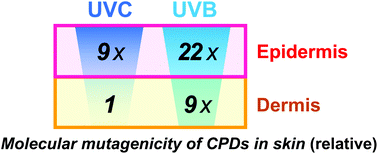当前位置:
X-MOL 学术
›
Photochem. Photobiol. Sci.
›
论文详情
Our official English website, www.x-mol.net, welcomes your
feedback! (Note: you will need to create a separate account there.)
Quantitative analysis of UV photolesions suggests that cyclobutane pyrimidine dimers produced in mouse skin by UVB are more mutagenic than those produced by UVC
Photochemical & Photobiological Sciences ( IF 2.7 ) Pub Date : 2018-02-07 00:00:00 , DOI: 10.1039/c7pp00348j Hironobu Ikehata 1, 2, 3, 4 , Toshio Mori 4, 5, 6, 7 , Thierry Douki 8, 9, 10, 11, 12 , Jean Cadet 13, 14, 15 , Masayuki Yamamoto 1, 2, 3, 4
Photochemical & Photobiological Sciences ( IF 2.7 ) Pub Date : 2018-02-07 00:00:00 , DOI: 10.1039/c7pp00348j Hironobu Ikehata 1, 2, 3, 4 , Toshio Mori 4, 5, 6, 7 , Thierry Douki 8, 9, 10, 11, 12 , Jean Cadet 13, 14, 15 , Masayuki Yamamoto 1, 2, 3, 4
Affiliation

|
The amount of photolesions produced in DNA after exposure to physiological doses of ultraviolet radiation (UVR) can be estimated with high sensitivity and at low cost through an immunological assay, ELISA, which, however, provides only a relative estimate that cannot be used for comparisons between different photolesions such as cyclobutane pyrimidine dimer (CPD) and pyrimidine(6-4)pyrimidone photoproduct (64PP) or for analysis of the genotoxicity of photolesions on a molecular basis. To solve this drawback of ELISA, we introduced a set of UVR-exposed, calibration DNA whose photolesion amounts were predetermined and estimated the absolute molecular amounts of CPDs and 64PPs produced in mouse skin exposed to UVC and UVB. We confirmed previously reported observations that UVC induced more photolesions in the skin than UVB at the same dose, and that both types of UVR produced more CPDs than 64PPs. The UVR protection abilities of the cornified and epidermal layers for the lower tissues were also evaluated quantitatively. We noticed that the values of absorbance obtained in ELISA were not always proportional to the molecular amounts of the lesion, especially for CPD, cautioning against the direct use of ELISA absorbance data for estimation of the photolesion amounts. We further estimated the mutagenicity of a CPD produced by UVC and UVB in the epidermis and dermis using the mutation data from our previous studies with mouse skin and found that CPDs produced in the epidermis by UVB were more than two-fold mutagenic than those by UVC, which suggests that the properties of CPDs produced by UVC and UVB might be different. The difference may originate from the wavelength-dependent methyl CpG preference of CPD formation. In addition, the mutagenicity of CPDs in the dermis was lower than that in the epidermis irrespective of the UVR source, suggesting a higher efficiency in the dermis to reduce the genotoxicity of CPDs produced within it. We also estimated the minimum amount of photolesions required to induce the mutation induction suppression (MIS) response in the epidermis to be around 15 64PPs or 100 CPDs per million bases in DNA as the mean estimate from UVC and UVB-induced MIS.
中文翻译:

对UV光损伤的定量分析表明,UVB在小鼠皮肤中产生的环丁烷嘧啶二聚体比UVC产生的环丁烷嘧啶二聚体更具致突变性
暴露于生理剂量的紫外辐射(UVR)后,DNA产生的光损伤的数量可以通过免疫测定法ELISA以高灵敏度和低成本进行估算,但是该方法仅提供了不能用于比较的相对估算值之间的不同光损伤,如环丁烷嘧啶二聚体(CPD)和嘧啶(6-4)嘧啶酮光产物(64PP),或在分子基础上分析光损伤的遗传毒性。为了解决ELISA的这一缺点,我们引入了一组暴露于UVR的校准DNA,其光损伤量是预先确定的,并估算了暴露于UVC和UVB的小鼠皮肤中产生的CPD和64PPs的绝对分子量。我们证实了先前报道的观察结果,在相同剂量下,UVC比UVB引起的皮肤光损伤更多,而且这两种类型的UVR产生的CPD都比64PPs多。还定量评估了下层组织的角质层和表皮层的紫外线防护能力。我们注意到,在ELISA中获得的吸光度值并不总是与病变的分子量成正比,尤其是对于CPD,要注意不要直接使用ELISA吸光度数据来估计光损伤量。我们使用先前对小鼠皮肤的研究中的突变数据进一步估计了UVC和UVB在表皮和真皮中产生的CPD的致突变性,发现UVB在表皮中产生的CPD的致突变性是UVC的两倍。 ,这表明由UVC和UVB产生的CPD的特性可能有所不同。差异可能源于CPD形成的波长依赖性甲基CpG偏好。另外,与UVR来源无关,CPD在真皮中的诱变性均低于表皮中的诱变性,表明真皮中降低其内产生的CPD的遗传毒性的效率更高。我们还估计,诱导表皮中的突变诱导抑制(MIS)反应所需的最小光损伤量约为DNA中每百万碱基的15 64PPs或100 CPDs,这是UVC和UVB诱导的MIS的平均值。
更新日期:2018-02-07
中文翻译:

对UV光损伤的定量分析表明,UVB在小鼠皮肤中产生的环丁烷嘧啶二聚体比UVC产生的环丁烷嘧啶二聚体更具致突变性
暴露于生理剂量的紫外辐射(UVR)后,DNA产生的光损伤的数量可以通过免疫测定法ELISA以高灵敏度和低成本进行估算,但是该方法仅提供了不能用于比较的相对估算值之间的不同光损伤,如环丁烷嘧啶二聚体(CPD)和嘧啶(6-4)嘧啶酮光产物(64PP),或在分子基础上分析光损伤的遗传毒性。为了解决ELISA的这一缺点,我们引入了一组暴露于UVR的校准DNA,其光损伤量是预先确定的,并估算了暴露于UVC和UVB的小鼠皮肤中产生的CPD和64PPs的绝对分子量。我们证实了先前报道的观察结果,在相同剂量下,UVC比UVB引起的皮肤光损伤更多,而且这两种类型的UVR产生的CPD都比64PPs多。还定量评估了下层组织的角质层和表皮层的紫外线防护能力。我们注意到,在ELISA中获得的吸光度值并不总是与病变的分子量成正比,尤其是对于CPD,要注意不要直接使用ELISA吸光度数据来估计光损伤量。我们使用先前对小鼠皮肤的研究中的突变数据进一步估计了UVC和UVB在表皮和真皮中产生的CPD的致突变性,发现UVB在表皮中产生的CPD的致突变性是UVC的两倍。 ,这表明由UVC和UVB产生的CPD的特性可能有所不同。差异可能源于CPD形成的波长依赖性甲基CpG偏好。另外,与UVR来源无关,CPD在真皮中的诱变性均低于表皮中的诱变性,表明真皮中降低其内产生的CPD的遗传毒性的效率更高。我们还估计,诱导表皮中的突变诱导抑制(MIS)反应所需的最小光损伤量约为DNA中每百万碱基的15 64PPs或100 CPDs,这是UVC和UVB诱导的MIS的平均值。











































 京公网安备 11010802027423号
京公网安备 11010802027423号